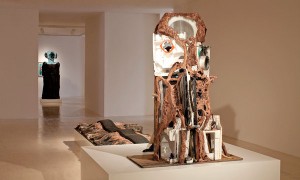‘Nothing beside remains,’ read Huma Bhabha, as she introduced her conference in Taylor Hall with Shelley’s Ozymandias on october 8th. From the start, the New York based artist established her interest in working with found materials to create new structures, ‘they become metaphors of themselves,’ she shared. And just like in Ozymandias, the weight of the past (use and function) of components is heavy in the mind after contemplation. There is something romantic about the fascination with the past, almost like a figure of nostalgia. Bhabha’s sculptures and drawings embody that rescue of what was thought to be lost to oblivion. She often works with salvaged materials that other artists in her studio reject, and incorporates them into her own process. Bhabha allows the materials themselves to dictate the course that each piece will take by ‘building from the remnants of the unwanted.’
Cinematography is an element Bhabha strives to build upon with her works. She will take photographs of her sculptures in specific settings as if on a stage, like a room in Mexico or dusk at the desert. Likewise, Bhabha enjoys exploring the levels of reception of her art. This means there is not always a clear beginning and end to a piece, a front or a back. The inside and outside merge, implying a most visceral extrication of meaning.
Looking at her work is like witnessing a tangible representation of human thought: it’s multilayered and polifacetic, it’s disturbing but bewitching. Juxtaposed fragments of mixed mediums coalesce to depict often untitled works, that range from pastel drawings to people in prayer made out of trash bags. Having worked in a taxidermy studio in Poughkeepsie, Bhabha acquired a collection of bones and understanding of anatomy dioramas that is now translated into the use of limbs and implication of movement in her pieces.
It is hard to say whether Bhabha intends to lend life to her pieces, but there is a definite challenge to planned obsolescence. Does she delay the destruction of ruins? Or is she playing with the boundaries of what we think is alive?
This is what then adds a ritualistic quality to her art, which she admires. Among carvings of cork and styrofoam, and urban graffiti friezes, there is a discourse of requiem that refuses to forget.
There is a unifying thread and it’s the frame of reference. Whether it be literary or chronological, arbitrary or deliberate, Bhabha’s works allude to other ideas. This allows her to explore the implied narrative of past works and complicate the notion of history and posthistory. Some of the influences and references mentioned were Rodin, Balzac, demons from Jeepers Creepers, Greek and Egyptian sculpture, and Karachi newspapers. She is constantly seeking, discovering, and transforming the elements she encounters.
The lecture culminated with psychedelic ink and pastel drawings that lean strongly upon symmetry, heavily influenced by Picasso. She sees herself as an artisan, and explains that ‘one thing leads to the next,’ in reference to the ease with which she transitions between art mediums. She works in the same space, thus her works inform each other.
The work of Huma Bhabha is a bridge; between the Classical and Sci-fi, among destruction and creation, redefining the void between existence and inertness. It’s playful yet cogent. It will make you have to question, and want to explore. It’s intellectually interactive, allowing as art does, to project our experiences into her already complex artwork.


